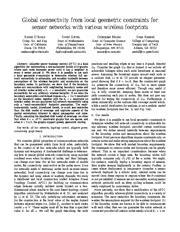A copy of this work was available on the public web and has been preserved in the Wayback Machine. The capture dates from 2010; you can also visit the original URL.
The file type is application/pdf.
Global connectivity from local geometric constraints for sensor networks with various wireless footprints
2006
Proceedings of the fifth international conference on Information processing in sensor networks - IPSN '06
Adaptive power topology control (APTC) is a local algorithm for constructing a one-parameter family of θ-graphs, where each node increases power until it has a neighbor in every θ sector around it. We show it is possible to use such a local geometric θ-constraint to determine whether full network connectivity is achievable, and consider tradeoffs between assumptions of the wireless footprint and constraints on the boundary nodes. In particular, we show that if the boundary nodes can communicate
doi:10.1145/1127777.1127784
dblp:conf/ipsn/DSouzaGMR06
fatcat:y3m7x3psqvebtg6okm5cgrwium

